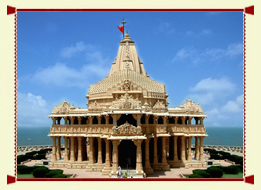 The Somnath in the Prabhas Kshetra in Saurashtra, on the western cost of Gujarat (INDIA) is one of the twelve Jyotirlings that are most scared to the Hindus. It is as old as creation and its reference is available in Rig Ved also. It is said - the Moon (Soma) with his wife Rohini worshipped the deity of the temple, the Sparsha Ling, to free himself from the curse of his father-in-law, Daksha Prajapati. Lord Shiva pleased with his penance restored his light for half of the month.
The Somnath in the Prabhas Kshetra in Saurashtra, on the western cost of Gujarat (INDIA) is one of the twelve Jyotirlings that are most scared to the Hindus. It is as old as creation and its reference is available in Rig Ved also. It is said - the Moon (Soma) with his wife Rohini worshipped the deity of the temple, the Sparsha Ling, to free himself from the curse of his father-in-law, Daksha Prajapati. Lord Shiva pleased with his penance restored his light for half of the month.
Hence the deity here is known as Someshwar or Somnath, Lord of the moon and the place as Prabhas. The Somnath is known as the Shrine Eternal as it has withstood the shocks of time and the attacks of the destroyers. It has risen like a phoenix each time it was destroyed or desecrated. The present temple is the seventh temple built on the original site. Sardar Vallabhbhai Patel, the great son of India and its first Deputy Prime Minister took a pledge on November 13, 1947 for its reconstruction which was completed on December 1, 1995 when the President of India, Dr. Shankar Dayal Sharma dedicated it in the service of the nation.
The present temple is built by Shree Somnath Trust which looks after the entire complex of Shree Somnath and its environs. The Present Temple, Kailash Mahameru Prasada is built in the chalukya style of temple architecture and reflects the inherent skill of Sompuras, Gujarat's master masons. It has the Shikhar portion, the Garbh Gruh, the Sabha Mandap and the Nritya Mandap. Such a temple has not been constructed in India during the last 800 years.
The Temple is situated at such a place that there is no land in between from Somnath sea-shore to Antartica, the South Pole. Such an inscription in Sanskrit is found on the ARROW-PILLAR erected on the sea-protection wall at the Somnath Temple. The Prabhas Kshetra is one of the most sacred places in India for Shaivaites as well as for Vaishnavites. Lord Krishna was hurt here at Bhalka in his foot by the arrow of a hunter who mistook him to be a deer.
There is Bhalkha Tirth temple at this sacred place. His mortal remains were cremated at Dehotsarga, on the banks of river Hiren. Shree Somnath Trust has built Dehotsarg canopy and Gita Mandir at Dehotsarga. The Dehotsarg canopy shelters "Krishna-Charan". The Trust has taken up project to develop this sacred place as "Shree Krishna Neejdham-Prasthan Teerth". Ahalyeshwar Mahadev Temple built by Queen Ahalyabai, Gita Mandir, Laxmi Narayan temple, Baldev Gufa, Mahaprabhuji's Bethak, Triveni Sangam, Parshuram Kshetra, SUN Temple, Prachi and Shashibhushan temples are other places of religious significance in and around the Somnath Temple.
Its earliest history fades into legend - it is said to have originally been built out of gold by Somraj, the moon god, only to be rebuilt by Rawana in Silver, then by krishna in wood and by Bhimdev in Stone. A description of the temple by Al Biruni, an Arab traveler, was so glowing that it prompted a visit in 1024 by a most unwelcome tourist - Mahmud of Ghazni. At that time, the temple was so wealthy that it had 300 musicians, 500 dancing girls and even 300 barbers just to shave the heads of visiting pilgrims.
Mahmud of Ghazni, whose raids on the riches of India are legendary, descended on Somnath from his Afghan kingdom and after a two-day-battle, took the town and the temple. Having looted its fabulous wealth, he destroyed it for good measure. So, began a pattern of Muslim destruction and Hindu rebuilding that continued for centuries. The temple was again razed in 1297, 1394 and finally in 1706 by Aurangzeb, the notorious Mughal fundamentalist.
After the 1706 demolition, the temple was not rebuilt until 1950. Outside, opposite the entrance, is a statue of S V Patel (1875-1950), who was responsible for reconstruction. The current temple was built to traditional designs on the original site by the sea. It contains one of the 12 sacred Shiva shrines known as jyoti linga. Photography is prohibited inside the temple, and you must leave your camera at the hut outside. There is a grey-sand beach outside the temple which is part of the temple's lonely seaside charm.
 |